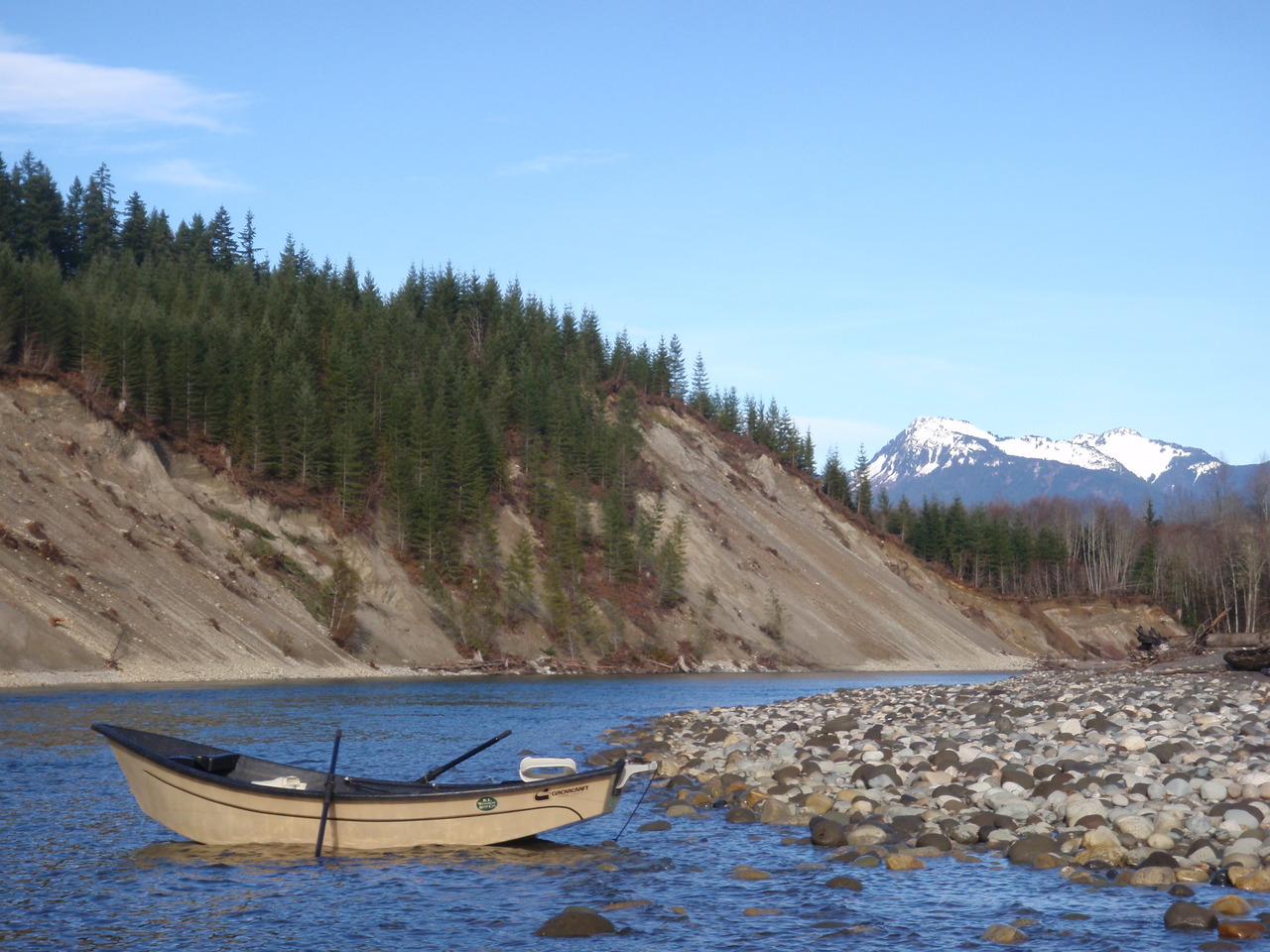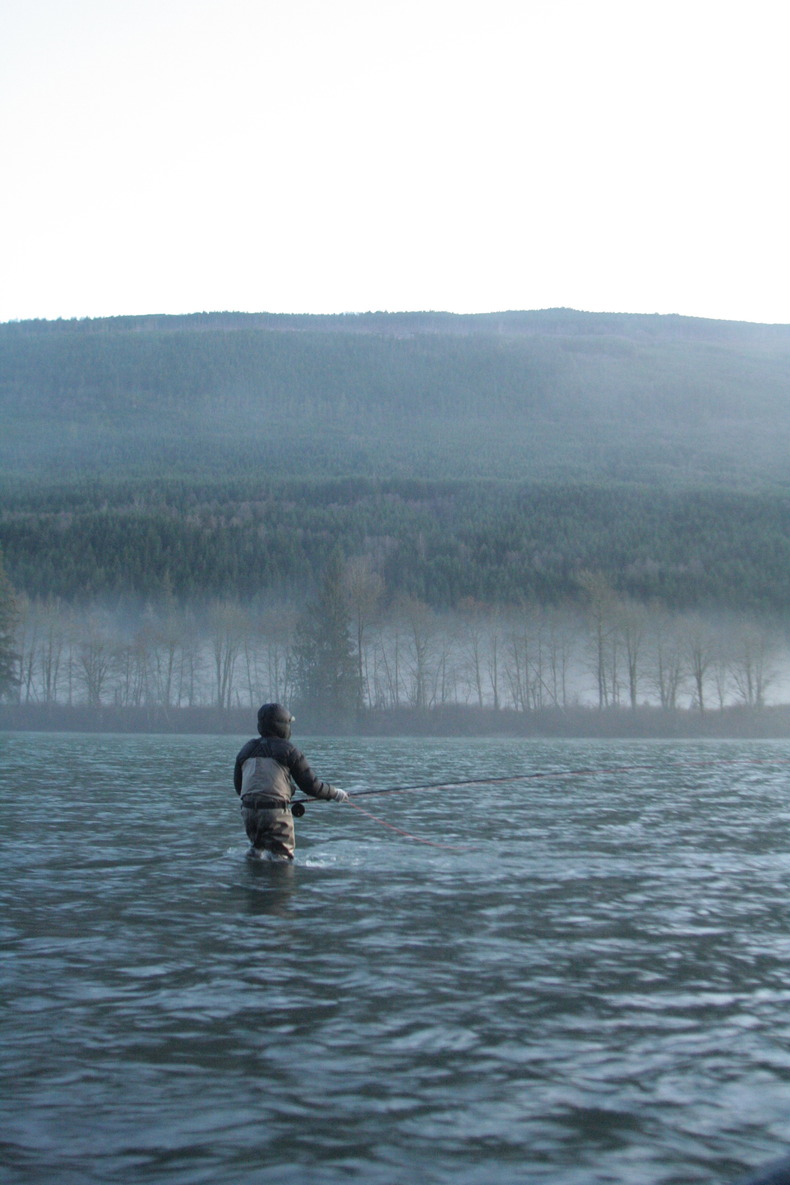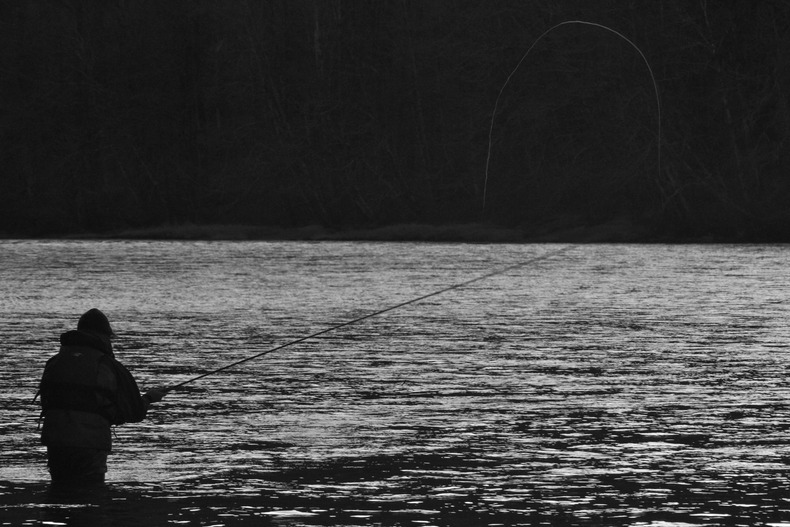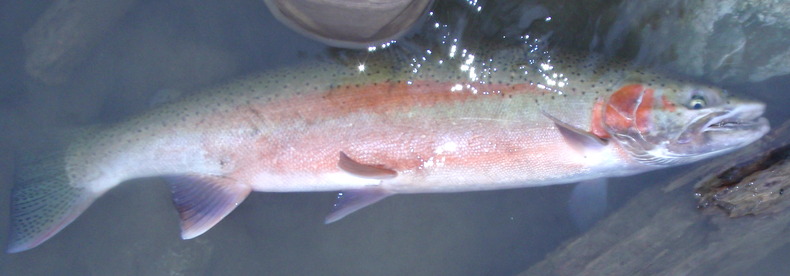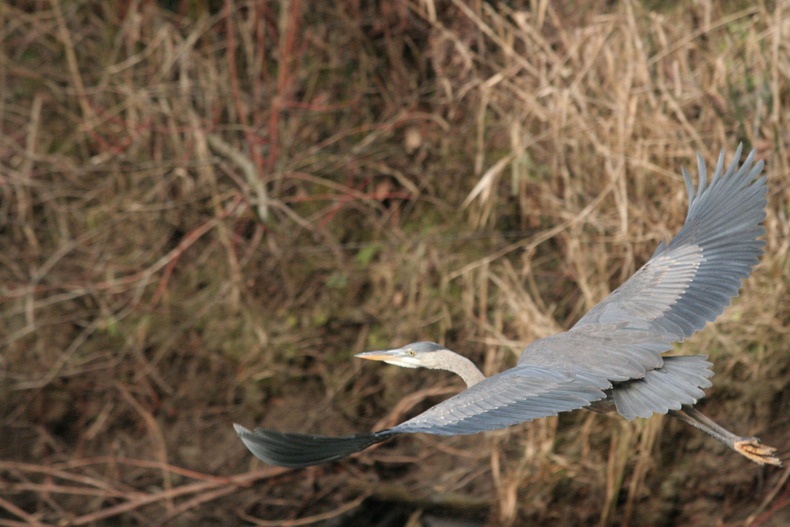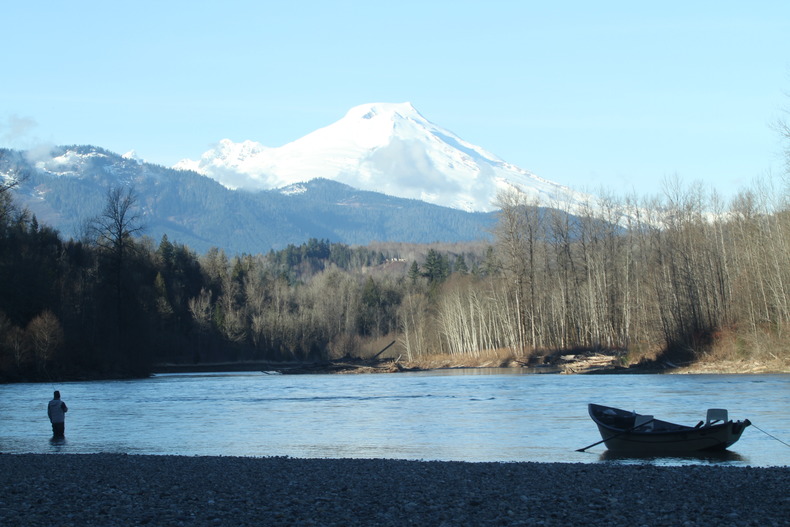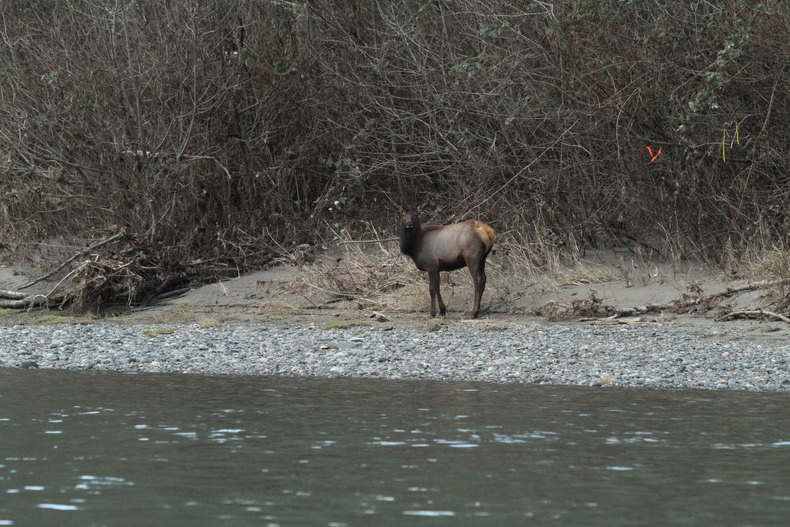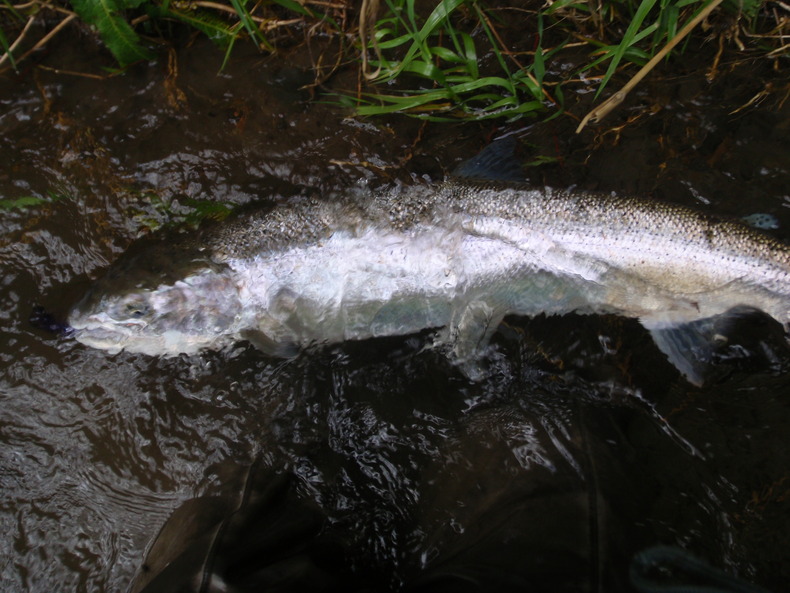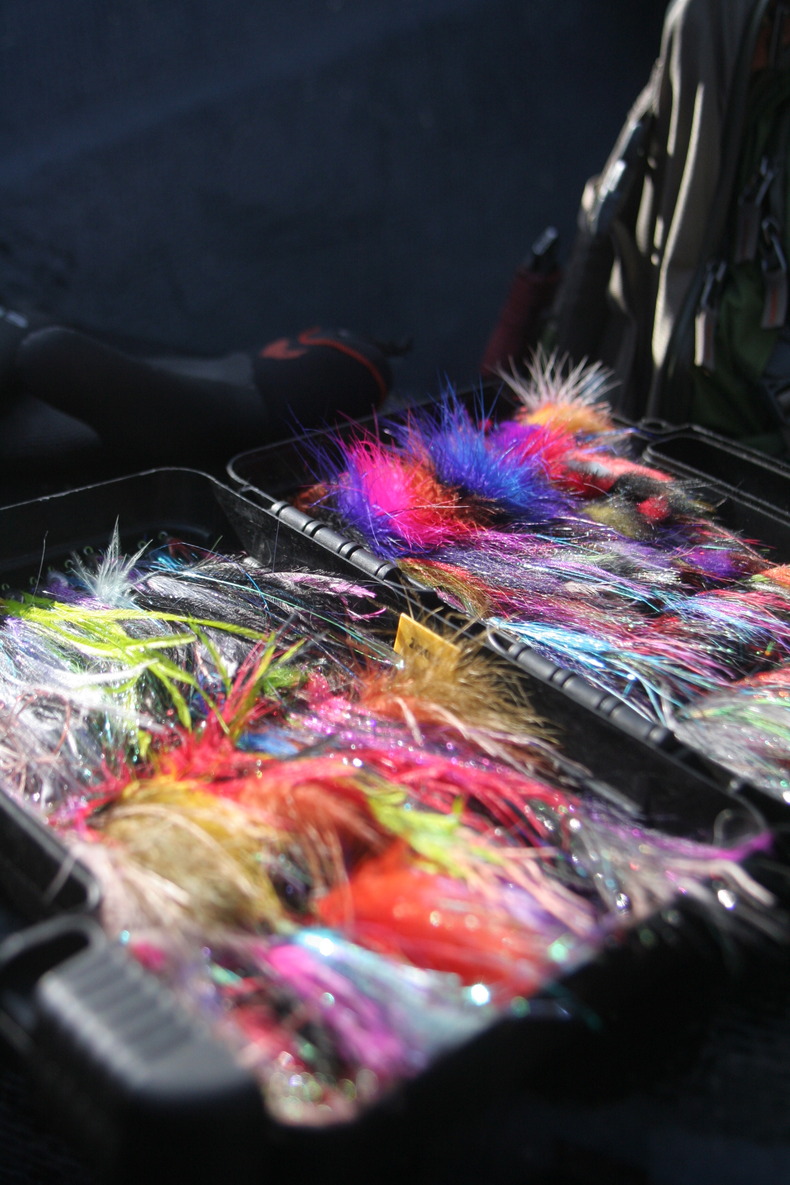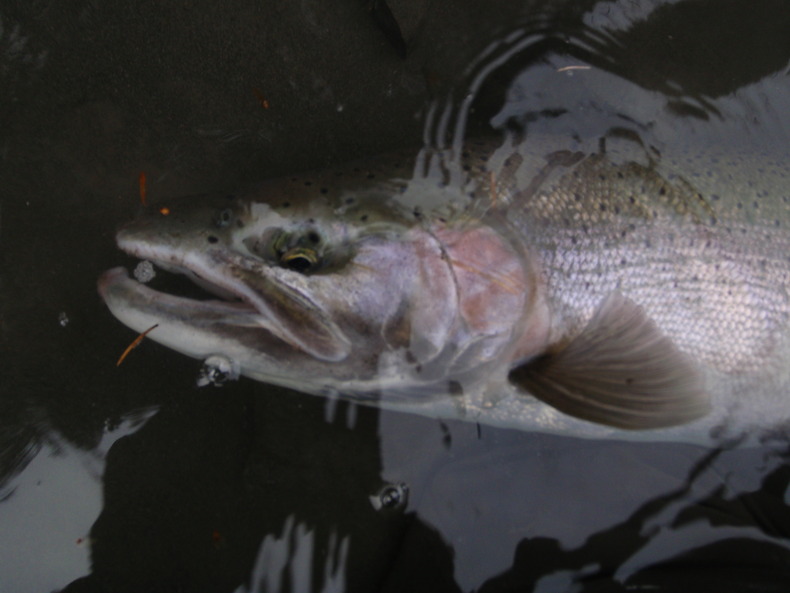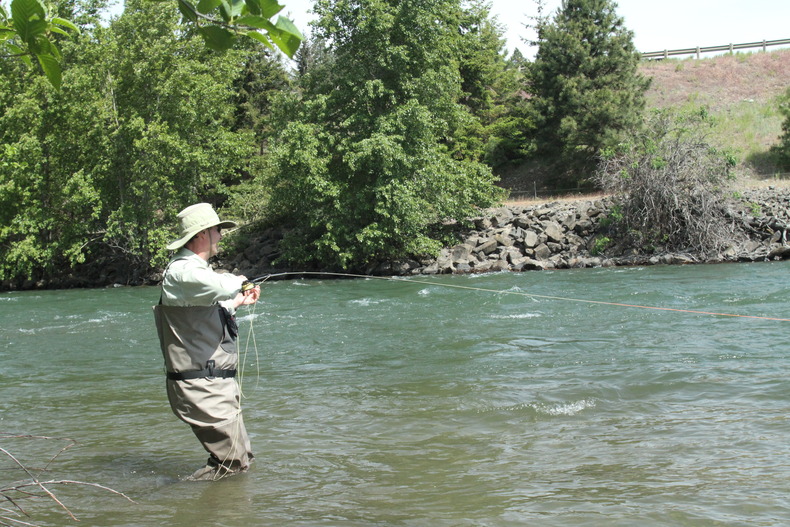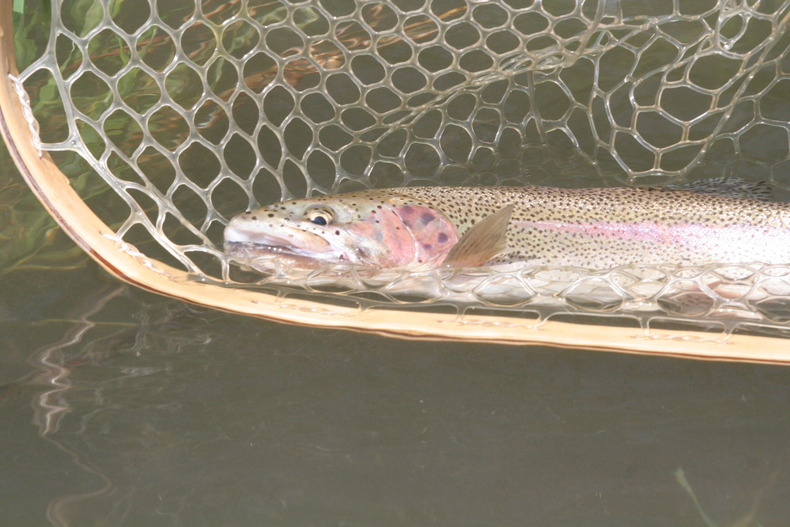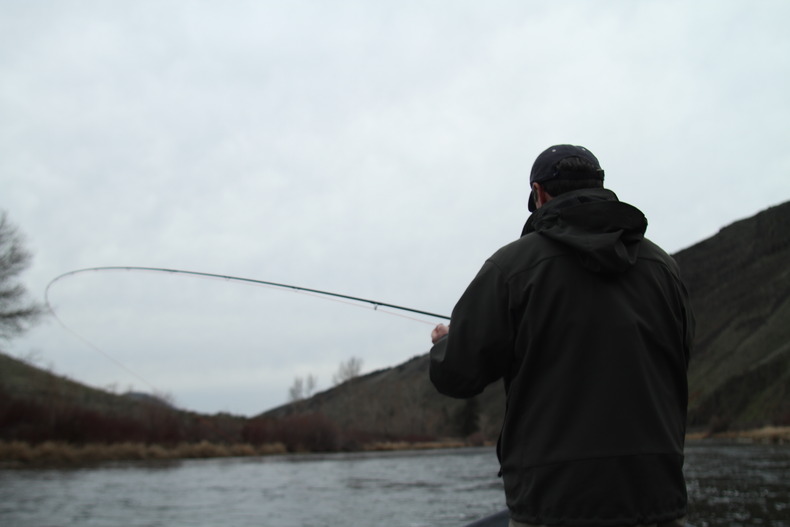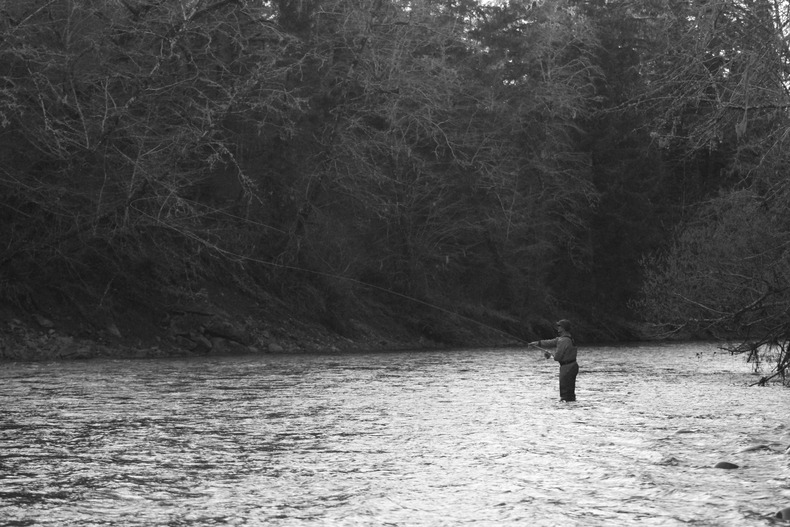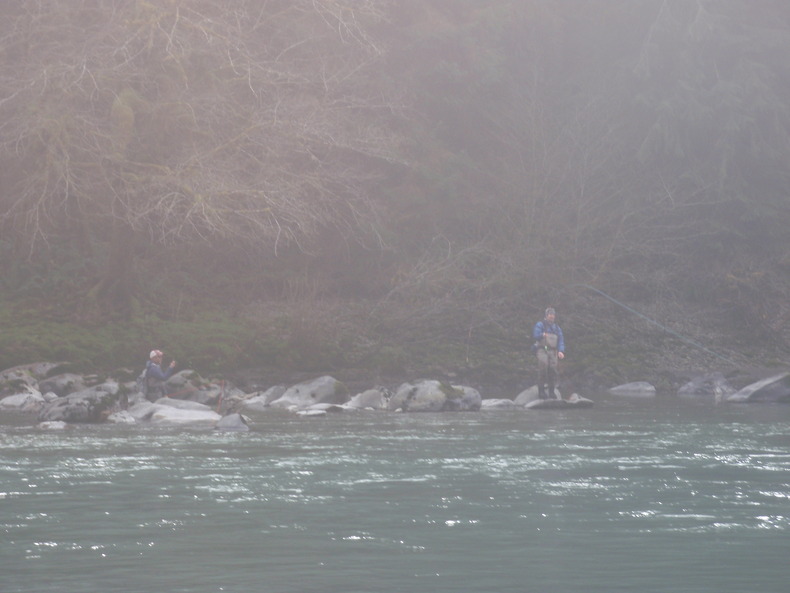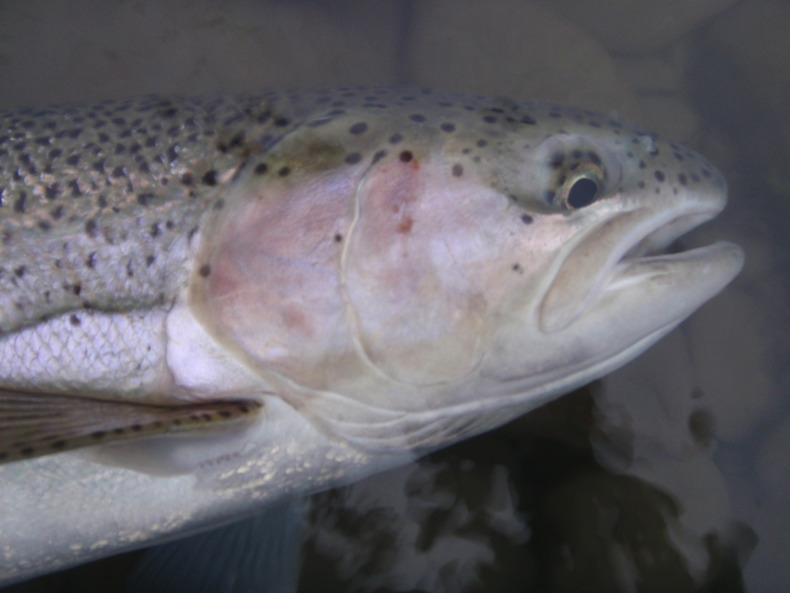Home Water Highlights
Guiding, Fishing, and Passing the Torch
Last winter and spring, I had the incredibly good fortune to fish the Skagit system and really get to know the rivers on the Olympic Peninsula. Working in a local fly shop affords a lot of opportunities to get outside with old clients and new friends, and I wouldn't trade the days I spent chasing Washington chrome for anything.
H-man swinging through the last run of the day
Although there may be more productive January waters, there's really something special about the Skagit. The more I fish it, the more I appreciate it. Storied runs, strewn with perfect structure, beg for the swung fly. The group of anglers who pioneered contemporary spey lines used the Skagit, and its legendary run of fish, as their testing grounds. It's mysterious, and huge. Some runs could indeed be fished most comfortably with the choice spey tackle of the last generation of spey fishers: 14 ft. rods at a minimum ... and long-belly lines with light tips!
Client and friend Lee setting up his cast with a circle spey
This river means a lot to me. I captured my first wild Puget Sound fish during the last catch-and-release season in '09. Since that time, it's been shut down by the end of January to protect the run. Despite the closure, I've tangled with a few Skagit chromers in its abbreviated fishing season and had great times with steelheading buddies. It's a place of pilgrimage, of great fish and the bigger-than-life anglers that pursue them. If I ever get to fish it again in March and April, it will mean much more than the simple pursuit of a single fish. It will be a homecoming.
My first truly wild Puget Sound fish, landed during the last catch-and-release season
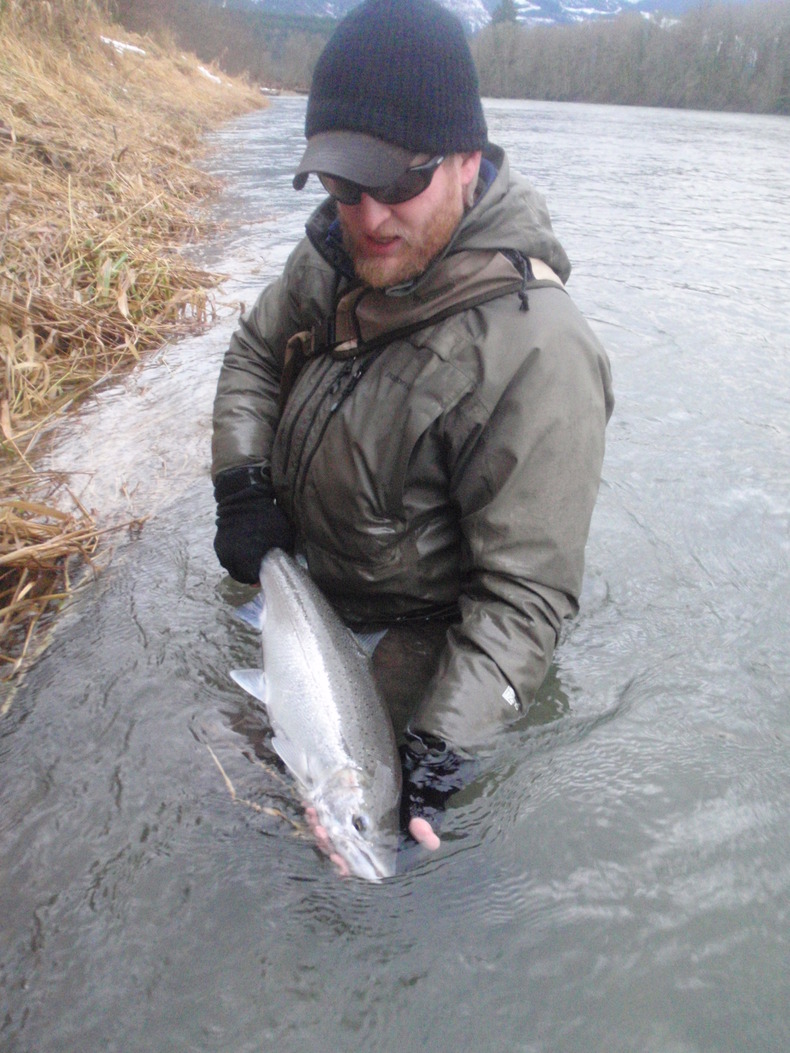
Fresh chromage among good company - also a few seasons old. This fish took within a rod length on a popular run.
I love guiding the Skagit even though most days are fishless except for a bull trout or two. When you do find a steelhead, it's burned in memory. It didn't happen in January, but simply spending time on these runs and transferring the knowledge that I've earned with my time on the water is reward enough to keep me coming back. The images below capture just a part of what makes this river so special.
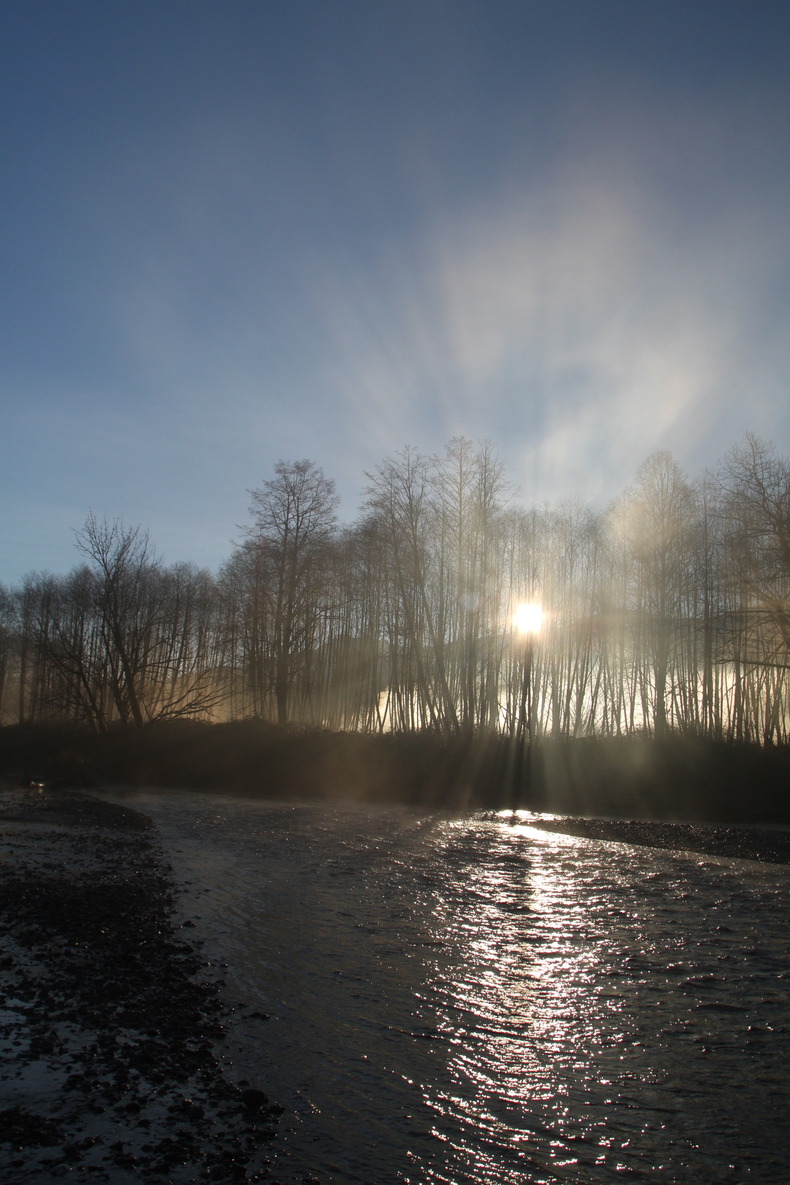
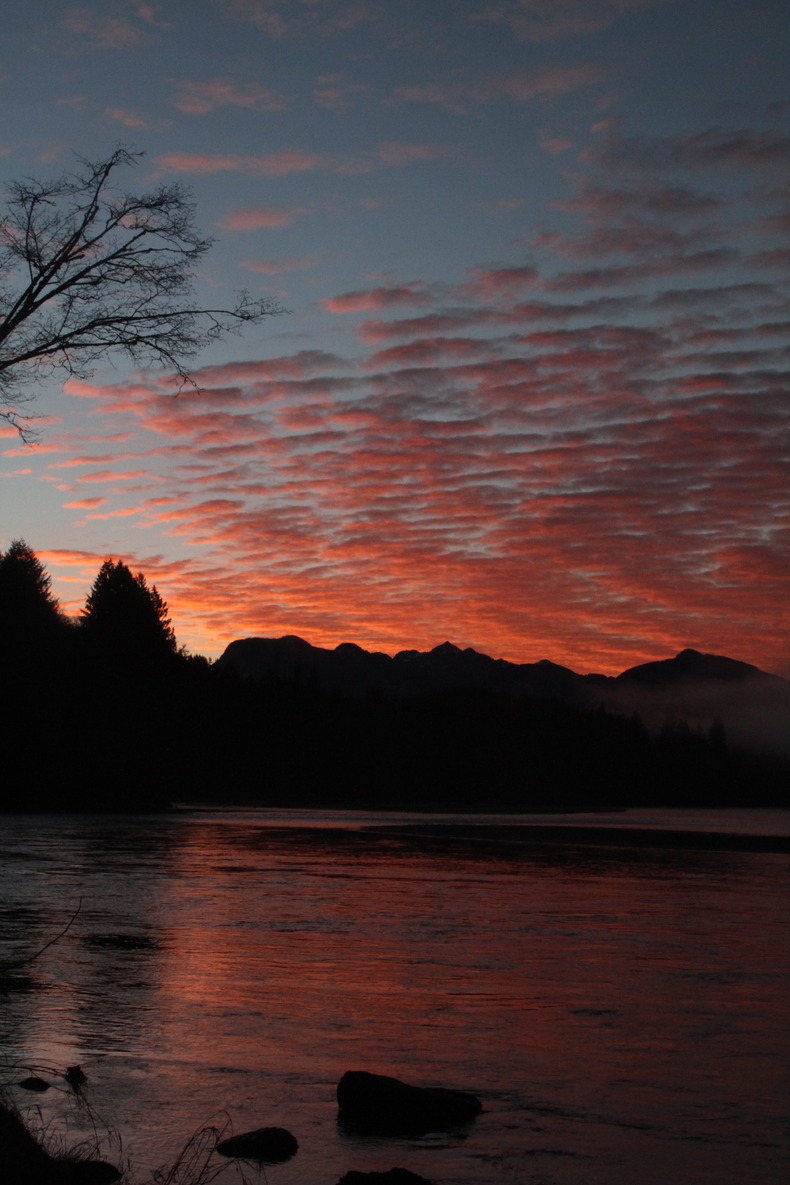
January came to a warm, sunny end and the Skagit system closed, so it was time to change focus to the Olympic Peninsula and the rivers near Forks. Fed by glaciers in the protected headwaters of the Olympic National Park, the waters of the coast are about as wild as it gets. Subject to harsh weather patterns and spreading out over incredibly varied terrain, the OP rivers can be trying. A wet weekend can make the rivers unfishable for days, which makes it really tough to plan time off with any predictability. You have to go when the rivers are in shape for a chance at success. I learned this lesson while vacationing out in Forks years ago. At the time I was pretty green, but I did hook a few fish and got a basic idea of the popular rivers. Several years down the line, I was eager to bring the knowledge I had gained since then and see what I could do with it.
Late April steel from my first trip to Forks. Barely landed. Better to be lucky than good!
The first challenge was high water. After a dry spell in January, the skies opened up and the rivers rose. I spent my first night on the coast in pounding rain, and had to get creative to find fishable water. The stretch I finally decided upon had just enough clarity to give me confidence, and more than enough depth make this hen feel safe in a thin tailout. She took with no hesitation, and I had my first fish to hand on my very first day on the coast, which is always nice!
The second challenge was low water. Between mid-February and mid-March, it didn't rain in the rainforest. The same weather pattern that robbed Washington of its snow depressed the fishing during this period, at least for those who fish the swung fly. Fish rely on fresh water of new rain to ascend the river, and when the river is low, they don't move upstream as readily. One of our relative new and super fishy shop hires, Dave J., came out to fish with me during a 3-day period of extreme low water and high air temps. Suffice it to say we didn't touch anything but bull trout—it was tough fishing! But we had a blast exploring new waters, and I was really glad to get to know Dave, a newcomer to Seattle by way of Colorado. In addition to being a lot of fun on the water, it turns out Dave has a problem with fly tying. He is subject to a serious addiction that causes him to tie brilliant flies whenever he has a spare moment. He's got it bad!
Dave is a fly tyer, writ large
One of the many runs Dave and I explored
During the same period of extreme low water, I finally decided to take it easy and lucked into this little Hoh buck. More about this special fish in Finding Your Pace.
Feisty and wild
The third challenge was fatigue coupled with distance. Realistically it's an eight-hour round trip to the coast, even if you hit the ferry right. It turns out camping multiple nights out of the week is a lot harder after you turn 30. The shop has been busier than I have ever seen it, which is fantastic! However, rolling in after 16 hr. days on the water with a steelhead hangover is no longer an option. Our customers are our lifeblood, and we work hard to make sure they have the best experience possible.
So after a couple successive weekends driving to Forks and no rain in the forecast, I was glad to make the relatively short drive to Ellensburg to trout fish with a long-time client and friend. He had recently had a life-changing event, and getting out on the water was particularly important. Fortunately, as is usually the case when I fish with Mr. P., the river fished well. Funny how that works. We had several nice trout to hand as well as hook-ups with two memorable fish. And when I say memorable, what I mean is SUPERHOTJUMBOFISH! These were the fish you love to see, but seldom get to the net. Both broke us off on heavy tippet. Not one, but two! Even when they kick your butt, simply encountering this class of fish keeps us coming back. More about the local trophy in Bridging the Gap, upcoming. Incredibly memorable, it was a great day on the Yakima.
Gettin' it done on a past trip, unique gillplate on this 'bow
Hooked up late day
One of the greatest joys for me is fishing with other anglers and passing on what I've learned. As is the case with guiding, sometimes what I'm trying to say falls on deaf ears, but most of the time it's well received. When it comes to swinging flies for steelhead, I take it seriously, especially the mental game required to swing for hours with no reward. I have been accused on more than one occasion of being enthusiastic to the point of incredulity, a badge I wear gladly. Ya just gotta be positive!
Fishing with the next generation of the Avid Angler crew has rewarding. Good anglers with solid backgrounds, they are hungry for the game, and I'm excited to see both of them learn the intricacies of the Puget Sound or wherever their travels take them. Dave and I fished early in the season under extremely tough conditions, and a fish did not materialize despite our best efforts. I got to know James, a newcomer from Virginia, under much better fishing conditions. In the last hour on the the trip, he landed an absolutely perfect April doe during a late-afternoon rainstorm. Tailed with newfound skill and patience, she never left the water and was on her way back upstream in moments.
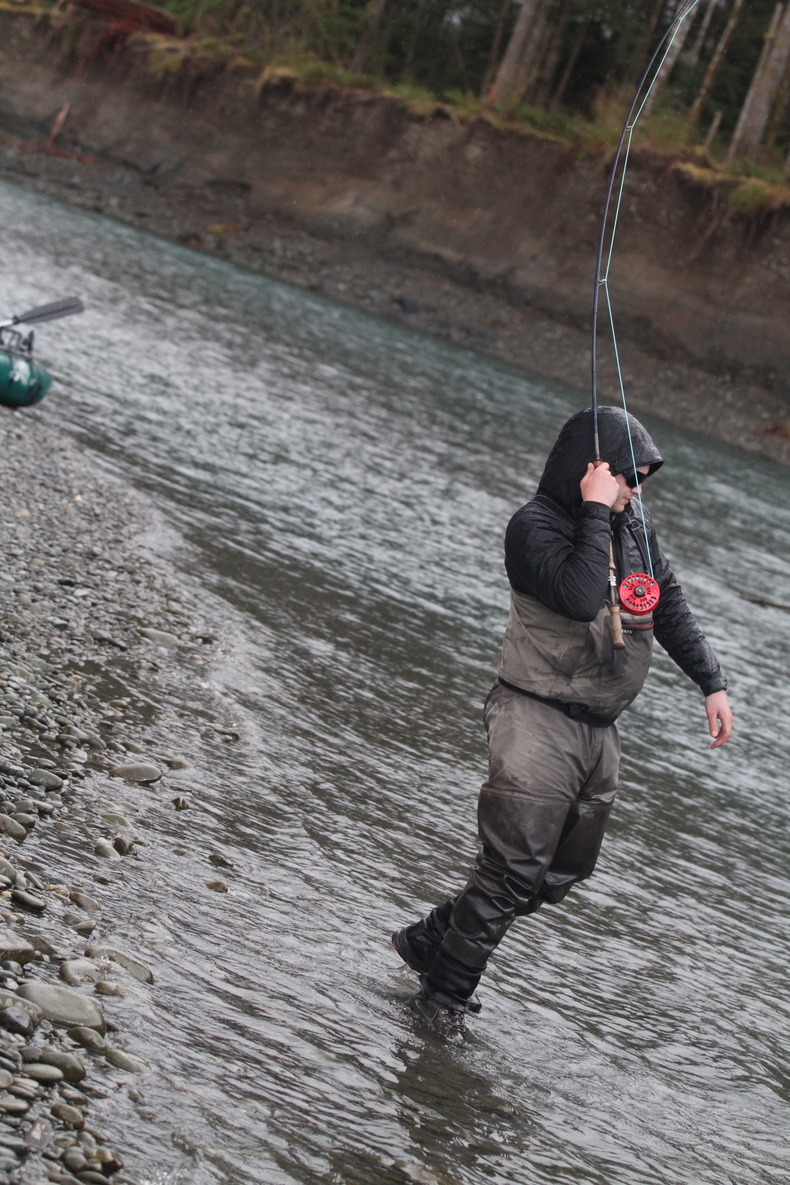
As mentioned earlier in the blog, this was unfortunately just a temporary gig for me. During the next few years of my life, I will not have the freedom to pursue coastal fish with any regularity, and I'm hanging up the guiding waders for a suit and tie. I always wanted to know what it would be like to be able to pursue spring steelhead with more than a weekend day, and I can say what I learned this season will last me for years. Great days with great people and great fish.
As I reflect on this very special season, a couple things come to the fore.
What I love most in all of fishing is exploring new water, fishing a new run with a couple good friends or in solitude, and unlocking its secrets. Maybe it's the REI background, but doing it with muscle-powered shuttling adds a ton to the experience. If anyone has any questions about how I ran my rig up and down the coast, please don't hesitate to contact me and I'll do my best to get back to you. It's not as hard as you might think, even though your average mileage on a float might decrease. This season, I got to explore more new sections of river than I ever thought I'd be able to tackle. Sometimes I found fish, sometimes I didn't. Always, it was intoxicating.
Wild steelhead do not come easy, no matter how you fish. I had tough days in low water with high sun where nobody on the river could buy a fish. I saw a great day on the upper reaches of a hitherto unexplored river where every angler I encountered hooked or landed a fish, myself included. I witnessed some absolutely horrible etiquette and ridiculously crowded waters, but I also witnessed commendable behavior from seasoned guides. It was enough to give me hope that I will be able to fish home water for steelhead in years to come. Even then, they will not come easy.
Steelhead hold in unexpected places. High bank one-off spots. Unusually shallow tailouts, and close to the bank. I even saw a fish swung up in some really ridiculous water right below a rapid where the lucky angler was standing on a rock in waist-deep water. The best recipe for success I encountered was being methodical and fishing each run thoroughly.
Everybody hooked a fish this day, and I was right across the run from these two anglers and got to see the whole fight!
Although I ran into a number of fish and hooked more than I landed, it was a pretty regular season for me. Not spectacular, but not bad either. I've found that winter and spring steelheading tends to even out into about one grab for every two full days (eight full hours) of fishing, at least it does for an angler like me. Sometimes you buck the trend, which is nice, and sometimes it's slower than that, which can really be brutal. But this rule held true over my time on the coast, with the exception of that period of really low water where I fished three full days before I finally ran into a fish. That was tough! What made the season for me, however, was exploring stretches of wild rivers which I will never again have the freedom to undertake. That, coupled with the company. The fish? Astounding. The ones that came to hand were special, each and every one. This is no surprise because that's what happens with steelhead, but it sure is nice to look back with some distinct memories.
This hen gave me the slow motion take! Sweet Agony!
To all who shared time on the water with me this past season—thank you! It was a very special time in my life.
A Season For Steelhead, Powder, Waves and Bonefish
